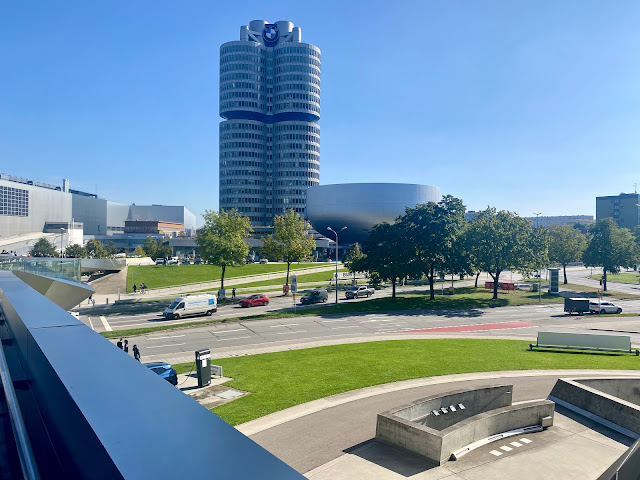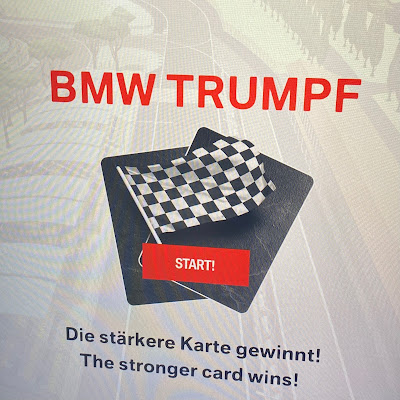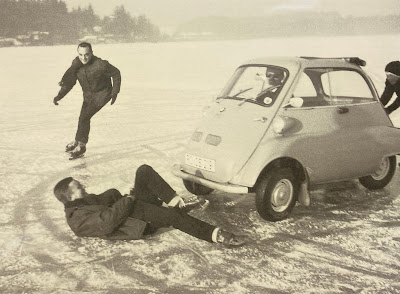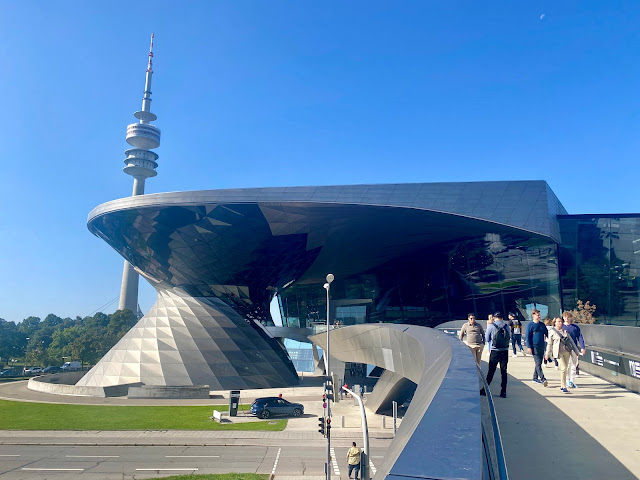You can't escape Germany's ugly history. A sobering gallery devoted to the use of forced labor by Baverische Motoren Werke during World War II deflated my giddy enjoyment of the company's groovy museum near Olympiapark, a short U-Bahn ride away from the city center. It's the building that looks like a cup. World headquarters towers above it.
The visit also helped me better understand why some of my Jewish friends in college vowed they would never buy German automobiles , no matter how well they were engineered.
These passport photos were found in recovered personnel files of mostly western European foreign workers whom BMW "recruited" from occupied countries to build aircraft engines for the Luftwaffe.
Initially, these foreign workers were treated almost as well as Germans employees albeit in segregated housing. But as labor shortages grew with military conscription, BMW enslaved concentration camp prisoners, mainly from Poland and Ukraine, to assemble piston engines in its factories. Once the war began, conditions for the foreign workers deteriorated so badly that foreign workers began dying at the same rate as concentration camp prisoners from overwork, disease and starvation.
To be fair, BMW addresses its past forthrightly, although perhaps without quite acknowledging the scale and duration of the its inhumane war-time employment strategy as I learned at Dachau two days later. This 1943 information graphic, also part of the exhibit, shows the relative geographical distribution of foreign workers over time at a concentration camp built in close proximity to a BMW factory near Munich specifically for the purpose of supplying forced labor. A more honest--and incriminating--report would have indicated how many of the more than 10,000 "auslanders" employed died on the job.
BMW began manufacturing airplane engines in 1916. By the time the National Socialists came to power in 1933, it was uniquely poised to profit from Germany's rapid militarization. This engine--which seems to gleam with Nazi menace--helped launch the London Blitz in 1940.
Is it me or does this simple, two-cylinder engine resemble a gas mask?
A da Vinci-like schematic diagram illustrates the innovation that helped BMW enter the car market six years later: water-cooled engines.
Soon enough well-to-do Germans were tooling around in sexy coupes. IMHO, this is one of the most beautiful cars ever made.
Leather straps held down its hood.
When I conjure the archetypal BMW in my mind, this is model, probably because the company first released it in 1966 after pivoting to the passenger car market. During my adolescence, the BMW 1600 quickly became a status symbol in both Europe and the United States, rescuing the company from financial collapse.
BMW also began developing its unique automobile categorization system around the same time. By the 1970s, it identified every model with a unique combination of numbers and letters, dizzyingly conveyed in this mobile.
The company continues to offer an amazing color palette.
It continued to pursue the motorcycle market too, introducing off-road bikes in the 1970s. BMW sold more than 200,000 motorcycles and scooters last year, the most in its history.
A look at the sponsors felt like hitching a ride in a sin-powered time machine piloted by a straight man.
Very few women visited the museum during the time I was there.
BMW isn't above dropping a name.
Can this be German . . . humor? Or a wink at the country's fascist past?
My father would have been delighted and I think a little surprised by my late-in-life interest in a car museum. Internal combustion engines obsessed him.
You've got to admit, they look a lot more powerful than an electrical board. Extinction imminently threatens the grease monkey.
Is it perverse that I found greater delight in the one-cylinder Isetta more than any of the high performance cars or motorcycles on display? You could drive nearly 80 miles on a single gallon of gas.
The owners were definitely in on the joke.
After visiting the Taj Mahal, I purchased a very expensive bejeweled elephant. That's way I stayed away from the BMW Welt, the futuristic showroom just across the street from the museum. I might have been tempted to go electric with BMW rather than Tesla!
More Bavaria:


























No comments:
Post a Comment